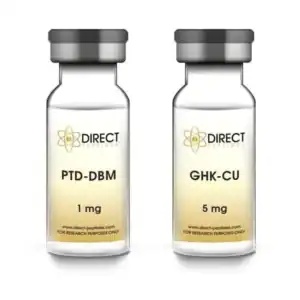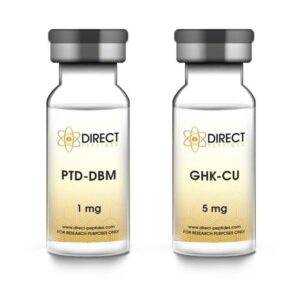Buy PTD-DBM Peptide Austria
Buy PTD-DBM, a peptide that helps regenerate hair follicles and supports hair growth by boosting cellular activity and improving nutrient delivery. It’s an effective ingredient for tackling hair loss and improving scalp health.
Shop our Full Range of PTD-DBM Peptides
-
Sale!

PTD-DBM Pre-Mixed Pen 1mg Peptide
£23.79 – £64.23Price range: £23.79 through £64.23 This product has multiple variants. The options may be chosen on the product page -
 NEW
NEWPTD-DBM GHK-Cu Peptide Stack
£30.50 – £39.48Price range: £30.50 through £39.48 This product has multiple variants. The options may be chosen on the product page -

PTD-DBM Nasal Spray
£25.19 – £45.38Price range: £25.19 through £45.38 This product has multiple variants. The options may be chosen on the product page -

PTD-DBM Peptide Vial
£18.89 – £27.87Price range: £18.89 through £27.87 This product has multiple variants. The options may be chosen on the product page
What Is PTD-DBM?
PTD-DBM, or Protein Transduction Domain-Dvl-Binding Motif, is a synthetic peptide designed to affect the Wnt/β-catenin signaling pathway. This pathway is a system of proteins that control cell growth, movement, and specialization, playing a crucial role in embryonic development and tissue maintenance.
It’s also essential for hair follicle cycling, impacting processes like cell function, follicle formation, and cell regeneration. By reactivating dormant hair follicles and supporting cell communication in the scalp, this pathway helps maintain healthy hair growth.
PTD-DBM specifically targets Dishevelled (Dvl) proteins, key players in the Wnt signaling process. By interacting with these proteins, the peptide helps regulate the pathway to promote hair growth and address hair loss conditions like androgenetic alopecia. This innovative approach makes it an important development in regenerative medicine and hair restoration therapies.
PTD-DBM Mechanism Of Action
PTD-DBM targets the Wnt/β-catenin signaling pathway, which is essential for hair follicle development and regeneration. This peptide works by blocking the interaction between Dvl (Dishevelled) proteins and molecules that prevent hair growth, allowing the Wnt pathway to function better.
By activating this pathway, PTD-DBM helps dermal papilla cells—key players in the hair growth cycle—multiply. It also regenerates dormant hair follicles and improves communication between scalp cells, creating the ideal conditions for hair growth. This focused approach makes PTD-DBM a significant advancement in addressing hair loss.
What Are The Research Benefits of PTD-DBM?
Hair Growth Peptide: It offers numerous benefits in promoting hair growth, particularly for individuals experiencing hair loss conditions such as androgenetic alopecia [1]. One of the primary advantages of this peptide is its ability to stimulate the Wnt/β-catenin signaling pathway, which is crucial for hair follicle activation and regeneration. Austria Research indicates that by enhancing this pathway, the peptide encourages the proliferation of dermal papilla cells, which are essential for initiating and maintaining the hair growth cycle [2].
Additionally, it has been shown to effectively regenerate dormant or miniaturised hair follicles, allowing them to re-enter the growth phase. This rejuvenation process promotes thicker, healthier hair strands over time. Furthermore, the peptide enhances cell-to-cell communication in the scalp, creating a supportive environment for sustained hair growth and improved scalp health [3].
Enhances Wound Healing and Tissue Repair: Austria Research has shown it to have great promise in supporting wound healing and tissue repair by boosting cell regeneration and communication. It helps fibroblasts, the cells responsible for producing collagen and structural proteins, to grow faster, which is crucial for closing wounds and maintaining tissue strength. By activating important signaling pathways, it speeds up the healing process, reducing the time it takes for wounds to recover [4].
Its ability to improve vascularisation helps increase blood flow to the affected area, delivering essential nutrients and oxygen to support tissue recovery. This improved environment not only speeds up healing but also reduces the risk of scarring and infection [5]. The peptide’s role in promoting cell migration and organising the extracellular matrix further highlights its effectiveness in supporting tissue regeneration. These qualities make it a promising option for advanced wound care and tissue repair [6].
Bone Regeneration: It is a promising breakthrough in bone regeneration therapy. It boosts the growth of osteoblasts, the cells responsible for forming and mineralizing new bone. By helping mesenchymal stem cells turn into bone-forming cells, the peptide speeds up the creation of strong, healthy bone tissue. It also improves blood flow to developing bones, ensuring they get the nutrients and oxygen needed for proper growth [7].
Additionally, it supports the production of the extracellular matrix, which acts as a framework for effective bone repair. These combined benefits make it an excellent option for treating bone fractures, defects, and conditions like osteoporosis, leading to better recovery and improved quality of life for patients.
Anti-Aging Potential: Austria Studies suggest it shows promise in anti-aging therapies by rejuvenating cells, boosting collagen production, and supporting tissue repair. It helps maintain skin elasticity, reduce wrinkles, and combat inflammation, promoting healthier and more youthful skin, muscles, and tissues.
Benefits in Neuroprotection: Austria Research shows potential in neuroprotection, with promising applications for treating neurological disorders and injuries. It protects neural cells, preserving essential neurons during damage or degenerative diseases. By supporting the conversion of neural stem cells into functional neurons, it helps repair damaged neural networks, restoring cognitive and motor functions.
It also reduces oxidative stress and inflammation, key factors in preventing further damage and promoting recovery. These qualities make the compound a promising option for conditions like traumatic brain injury, stroke, and neurodegenerative diseases, offering hope for better outcomes and improved neurological health [8].
Buy PTD-DBM Peptide for research use online today!
Buy PTD-DBM GHK-Cu Peptide Stack
Buy PTD-DBM and GHK-Cu peptide stack for research. They may potentially work together to enhance tissue repair and regeneration.
PTD-DBM Austria boosts Wnt/β-catenin signaling for tissue repair, while GHK-Cu supports skin healing, collagen production, and reduces inflammation. Combined, they could offer a powerful solution for wound healing, skin rejuvenation, and tissue repair.
Buy PTD-DBM Pre-Mixed Pen
Buy PTD-DBM Pre-Mixed 1 mg Pen, a ready-to-use solution for precise and easy application of PTD-DBM peptide Austria. Its user-friendly design ensures consistent and effective delivery.
Pre-Mixed Cartridge Kits include a cartridge (pre-mixed with your chosen peptide and Bacteriostatic Water), a peptide pen, carry case, and 3 pen needle tips. Single Mixed Cartridges (1, 2, or 3) come with the cartridge and 3 needle tips but no kit. Save 10% when purchasing 3 cartridges!
Frequently Asked Questions (FAQs) about PTD-DBM
Are there any side effects associated with PTD-DBM?
While it is generally well-tolerated, there have been some reports of minor side effects, such as mild irritation at the injection site. If you notice any adverse reactions, discontinue and consult a healthcare professional immediately.
Is PTD-DBM legal?
Yes, it is legal for research purposes in many countries, but it is not officially approved for personal use as a medical treatment. Regulations vary depending on your location. In the United States, the FDA has not approved it for human or animal consumption. Before you buy PTD-DBM, check the laws and guidelines in your country and always ensure you purchase it from a reputable, authorized supplier.
How should PTD-DBM be stored?
It should be stored in a cool, dry place and kept away from direct sunlight. It is recommended to refrigerate the solution to maintain its effectiveness.
What works better with PTD-DBM for healthy hair: Methyl Vanillate or Valproic Acid?
When comparing Methyl Vanillate and Valproic Acid as combinations with PTD-DBM for healthy hair, the choice depends on the goals and mechanisms targeted.
Valproic Acid enhances Wnt/β-catenin signalling, promoting hair follicle regeneration and dermal papilla cell activation, making it effective for stimulating new growth.
Methyl Vanillate offers strong antioxidant and anti-inflammatory properties, supporting scalp health and protecting against factors that hinder growth.
Pairing PTD-DBM with Valproic Acid may directly boost follicle activation, while Methyl Vanillate is better for maintaining scalp health. The best approach may depend on individual needs, potentially combining both for maximum PTD-DBM therapy benefits.
Can PTD-DBM be combined with other peptides?
Yes, it can be stacked with other peptides like GHK-Cu to enhance its benefits. This combination may provide synergistic effects, improving both hair and skin health.
Buy PTD-DBM peptide vial Austria available in 1 mg from Direct Peptides.
Summary of Research Applications
- Enhances hair follicle regeneration.
- Improves the appearance of thick hair.
- Promotes bone repair.
- Potential anti-aging effects for skin.
- Enhances tissue repair and wound healing.
- Neuroprotection.
PTD-DBM Peptide Quality Assured
Buy PTD-DBM peptide Austria with over 98% purity from Direct Peptides, designed to support your scientific research. Our products are third-party tested to ensure quality and reliability, giving you confidence in your results. With a focus on safety, precision, and consistency, we provide what your research needs to succeed.
References For Further Reading
[1] Yeong Chan Ryu,Jiyeon Park, You-Rin Kim, Sehee Choi, et al (2023) CXXC5 Mediates DHT-Induced Androgenetic Alopecia via PGD2 – Cells 2023, Volume 12 (Issue 4), Page 555.
[2] Soung-Hoon Lee, Seol Hwa Seo, Dong-Hwan Lee, Long-Quan Pi, et al (2017) Targeting of CXXC5 by a Competing Peptide Stimulates Hair Regrowth and Wound-Induced Hair Neogenesis – Journal of Investigative Dermatology, 2017 Nov, Volume 137 (Issue 11), Pages 2260-2269.
[3] Yeong Chan Ryu, Dong‐Hwan Lee, Jiyong Shim, Jiyeon Park, et al (2021) KY19382, a novel activator of Wnt/β‐catenin signalling, promotes hair regrowth and hair follicle neogenesis – British Journal of Pharmacology, 2021 May 5, Volume 178 (Issue 12), Pages 2533–2546.
[4] Soung-Hoon Lee, Mi-Yeon Kim, Hyun-Yi Kim, Young-Mi Lee, et al (2015) The Dishevelled-binding protein CXXC5 negatively regulates cutaneous wound healing – Journal of Experimental Medicine, 2015 Jun 29, Volume 212 (Issue 7), Pages 1061–1080.
[5] Sehee Choi, Minguen Yoon, and Kang-Yell Choi (2021) Approaches for Regenerative Healing of Cutaneous Wound with an Emphasis on Strategies Activating the Wnt/β-Catenin Pathway – Advances in Wound Care (New Rochelle), 2021 Nov 11, Volume 11 (Issue 2), Pages 70–86.
[6] Yutong Chen, Xiaofeng Ding, Zhouji Ma, Shuai Shao, et al (2025) CXXC5 function blockade promotes diabetic wound healing through stimulating fibroblast and vascular endothelial cell activation – Cell Communication and Signaling, volume 23, Article number: 108 (2025).
[7] Hyun-Yi Kim, Sehee Choi, Ji-Hye Yoon, Hwan Jung Lim, Hyuk Lee, et al (2016) Small molecule inhibitors of the Dishevelled-CXXC5 interaction are new drug candidates for bone anabolic osteoporosis therapy – EMBO Molecular Medicine, 2016 Apr 1, Volume 8 (Issue 4), Pages 375-87.
[8] Bianca Marchetti, Cataldo Tirolo, Francesca L’Episcopo, Salvatore Caniglia, et al (2020) Parkinson’s disease, aging and adult neurogenesis: Wnt/β-catenin signalling as the key to unlock the mystery of endogenous brain repair – Aging Cell, 2020 Mar, Volume 19 (Issue 3), Page e13101.
Why Choose Direct Peptides Austria?
Buy PTD-DBM today from Direct Peptides Austria, your trusted source for high-quality peptides. We offer a wide range of products, including 1 mg peptide vials, peptide stacks with potential synergistic effects, nasal sprays in 15ml and 30ml bottles, and 1 mg pre-mixed peptide pens. Designed to meet diverse research needs, we make sure Austria researchers can find the exact formulations they need for their projects.
ALL CONTENT AND PRODUCT INFORMATION AVAILABLE ON THIS WEBSITE IS FOR EDUCATIONAL PURPOSES ONLY.
DISCLAIMER: These products are intended solely as a research chemical only. This classification allows for their use only for research development and laboratory studies. The information available on our Austria Direct Peptides website: https://austria.direct-peptides.com is provided for educational purposes only. These products are not for human or animal use or consumption in any manner. Handling of these products should be limited to suitably qualified professionals. They are not to be classified as a drug, food, cosmetic, or medicinal product and must not be mislabelled or used as such.
Related Posts

Role of PTD-DBM and GHK-Cu in Hair Growth
This blog discusses how PTD-DBM and GHK-Cu peptides support hair growth. It activates the Wnt/β-catenin pathway, while GHK-Cu reduces inflammation and stimulates growth factors to nourish hair follicles. Early research shows promise, but these peptides are still experimental and require further study to fully understand their potential in addressing hair loss.

Epitalon Hair Growth: Research Insights
This blog explores the potential of Epitalon, a peptide linked to telomerase regulation, in promoting hair growth and scalp health. Early research suggests it may support keratin production, collagen synthesis, and reduce scalp inflammation, impacting key hair growth phases like anagen and telogen. The blog also compares Epitalon to other peptides like GHK-Cu and PTD-DBM, emphasizing the need for further studies to confirm its role in addressing hair thinning and follicle health.

AHK-Cu vs GHK-Cu: Key Differences and Benefits
This blog compares AHK-Cu and GHK-Cu, two copper peptides commonly used in skincare, hair restoration, and regenerative medicine. AHK-Cu excels in promoting hair growth, while GHK-Cu is versatile, aiding skin regeneration and collagen production. The article highlights their differences to help researchers choose the right peptide for their needs.



